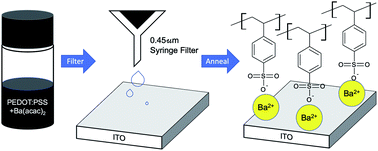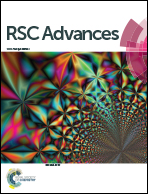Work function modification of PEDOT:PSS by mixing with barium acetylacetonate†
Abstract
Poly(3,4-ethylenedioxythiophene)polystyrene sulfonate (PEDOT:PSS) is often used as a hole injection and extractor for various organic electronic devices. This study investigated whether it is possible to n-dope PEDOT:PSS with barium acetylacetonate (Ba(acac)2) to change its work function so that to be more suitable for electron injection and extraction. Molecular dynamics simulations suggested that barium cations can interact with the aromatic rings of PEDOT and the negatively charged sulfonate in PSS. At high doping concentration, we found that PEDOT became dedoped and precipitated resulting in a clear solution after filtration. The absence of the absorption peak of PEDOT at 263 nm indicates the removal of PEDOT after filtration. The shift in O 1s to a lower binding energy as seen in X-ray photoelectron spectroscopy suggested that the polystyrene sulfonic acids are being ionized to form barium polystyrene sulfonate (Ba–PSS). By spin-coating the solution on top of indium tin oxide, the work function can be adjusted to as low as 3.6 eV. The ability of such a mixture to inject and extract electrons is demonstrated using 2,7-bis(diphenylphosphoryl)-9,9′-spirobifluorene as an electron transporting layer. We attributed the lowering of the work function as the result of the formation of an interfacial dipole as large as 1.37 eV at the ITO/Ba–PSS interface.



 Please wait while we load your content...
Please wait while we load your content...